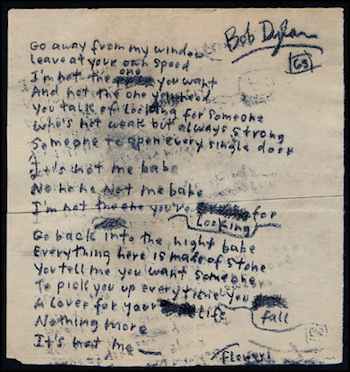By Danielle Arnet

Bob Dylan's Handwritten Lyrics
Bob Dylan's handwritten lyrics for the song that became 'It Ain't Me Babe' sold for $24,000 recently in a Gotta Have It! Internet auction.
Q: In 1974, I bought an original final draft, signed by Michael Landon, of a script for "Little House on the Prairie." Value?
Q: I have a Desert Inn directory personally autographed for me by Ed Sullivan the first time Carol Burnett appeared in his Vegas show. I recently had it PSA/DNA graded and authenticated. They graded it a 7. How do I get current value, and where do I sell it?
Q: Wondering about several framed documents, including a 1785 travel expense summary for a New Hampshire circuit court judge, plus court summons dated 1791 and 1809, all with intact wax seals. Value?
Q: Are my 1922 German bonds worth anything, or should I toss them?
A: I wonder if today's writers have seriously thought about the law of supply and demand as it relates to their items.
In simplest terms, the idea is that in a competitive market, the price for any item will vary according to relationship between the quantity wanted by consumers and the quantity available. Shifts in the market can affect the classic curve.
And, boy, has the market shifted! Today's smart collector will not buy unless a.) they absolutely relate to the item, and/or b.) they are convinced they're buying the very best they can afford.
The Dylan lyrics illustrating this column are a perfect example of what fuels demand. First, they were handwritten by an iconic artist (direct attribution). Plus, the lyrics relate to a song forever linked to Dylan. And, above all, the artist is significant to today's buyer (relationship).
To sell smart, first narrow down the target buyer. Take a cold, objective look at the item and ask, who will want this particular document, or script or bond or autograph, and why? What makes it an in-demand item, or does it fall short? Dig out the strong points. Then be brutally objective about flaws such as condition or lack of demand.
Demand on the first query relates to television history. I'd shop the draft to auction houses that sell Hollywood memorabilia. The Landon autograph will be a major key to attracting interest.
If the Desert Inn material mentions the Burnett debut, that's significant. If so, it might qualify for a celebrity auction. Without important content, you simply have a directory bearing Ed Sullivan's autograph to sell. Joe Orlando, president of PSA/DNA, tells us a 7 rating means "near mint," so that's a plus. Perhaps the directory plus signature can be marketed as a piece of Vegas history.
The historic documents need to be seen to determine authenticity and condition. A credentialed appraiser is needed to set value. Yes, that costs. If the aim is to sell, I'd shop them to auction houses that have books and manuscripts sales. They will know value.
The German bonds from 1922 are in the category of philatelics. For basic info, look on eBay, where we found quite a few posted. Then Google the exact type for more info. Next, take the bonds to a stamp or paper money show and ask dealers. Never toss anything out without thinking through options first.
COLLECTOR QUIZ
QUESTION: Can you match the costume jewelry materials with eras in which they were popular?
1. Carved wood
2. Plastic beads
3. Plated silver settings
4. Frosted Lucite
a. 1960s
b. Early 1960s
c. 1940s
d. 1930s-40s
ANSWERS: 1-d, 2-b, 3-c, 4-a. Source: "Classic American Costume Jewelry," Vol. 2, by Jacqueline Rehmann (Collector Books, $24.95).
Hobbies & Collecting ...
AUTOS | HOBBIES | EDUCATION | FAMILY | FASHION | FOOD & RECIPES | HOME DECOR | RELATIONSHIPS | PARENTING | PETS | TRAVEL | WOMEN
Collecting - Buyers Much Pickier in Today's Collectibles Markets
Article: Copyright © Tribune Media Services